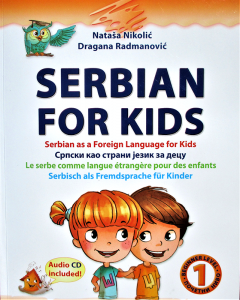A Review of “Serbian for Kids 1”
Gordana Sokic B.A., M.Ed.
Whether they live outside of Serbia, the country of one or both of their parents, or in Serbia, surrounded by the language which is not the language of their parents, many children want to learn Serbian as their second, or even third language. They look for ways of connecting (or re-connecting) with the Serbian culture, of making clearer ties between the world at home and outside of it, or of simply finding a voice inside of them which could represent a part of their identity, a part that they might lose was it not for the attempt to learn the language connected with it.
“Serbian for Kids” is for such children; it is there to help them find that inner voice, discover the culture, and become active participants in it by learning how to understand and communicate in Serbian. The book is unique in many ways – it is the first book which introduces Serbian to children in a communicative, fun way and through context which they can identify with. Many of the phrases covered in the book children use on a daily basis in their first language, while situations described in the book are those that children often find themselves in.
“Serbian for Kids” introduces various language points (grammar and functions) step by step, giving learners plenty of opportunities to practice them through interactive and engaging activities. They meet Milica and Marko and their friends, they go to school with them, find out about their family, celebrate Christmas, go to visit their grandparents in Serbia and sing a birthday song with them. They are guided by wonderful illustrations that bring the characters to life, and by simple and effective instructions aimed at helping them start to communicate, verbally and in writing, in Serbian.
Finally, “Serbian for Kids” plays a role in the life of not only the learners and their families but also of society by celebrating diversity and helping maintain one heritage language. It crosses cultural boundaries and reminds us that a fight for one’s language is also a fight for a better world.



